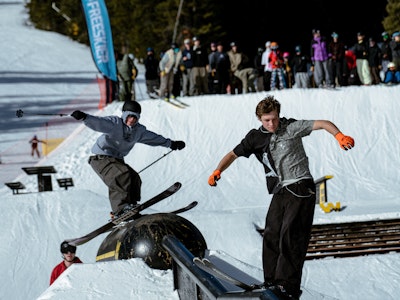Words: Brad Fayfield
Photos: Sam McCrae
One of the greatest benefits of the Olympics in Whistler is that the mountain is wide open because everyone is attending the events. It"™s an incredible time to ski and ride. So when I was invited to catch an early morning chair with the Blackcomb ski patrol, I was all in.
My motivation was twofold: Get on the mountain before anyone else had a chance to tap into the goods; and get a behind-the-scenes look at what these patrollers do to keep one of the rowdiest mountains North America safe.
Local photographer Sam McRae met me at the chair at 7:30am, where Adam Mercer, the Supervisor of Blackcomb Mountain"™s ski patrol, welcomed us. The three of us piled on the lift and headed up. I couldn"™t help but think that this was Adam"™s "commute" to work – coffee in hand, backpack full or his work gear, and skis dangling from his feet as the sun poked over the mountain and welcomed us. What a commute to the office.
Adam is the man, and he"™s been patrolling at Whistler Blackcomb for over ten years. On the chair he gave us a brief explanation of the way the Blackcomb patrol team operates. "Typically, if the mountain receives 10cm or more of snow, we"™ll need to do avalanche control," he explained. Last night was dry, so there"™d be no avalanche work this morning. I was a bit bummed as I was hoping to see these guys trigger some slides.
On a typical morning that requires avalanche blasting, a group of about six-eight patrollers head up on sleds at the crack of 6am to start working. Depending on snowfall, the crew can get the avalanche-prone areas opened up by early afternoon. Explosives are used only when absolutely necessary. The risk of "duds" and the cost of explosives make it an "only-when-needed" method of avalanche control. A huge day of blasting can cost upwards of $10,000 (including heli bombing etc).
In a heavy month, avalanche work can be consuming. "November was really busy for us because it was the most snow on record in the month of November," Adam explained. "But it"™s been very quiet lately due to the Olympics. There just aren"™t as many people skiing right now, and the snow fall has been manageable."
When we got to the top of the mountain we jumped into the 8am patroller meeting. Adam headed the gathering, which was comprised of about 30 patrollers (almost half of whom were women – nice). They recapped the prior day"™s activities, and the day ahead. Nothing too serious happened the previous day, and no blasting was to take place this morning so the mood was light, yet professional. These patrollers took their jobs seriously, no question.
One of the more interesting topics was the discussion surrounding the weather patterns and snow pack, which was led by Senior Avalanche Forecaster Tony Sittlinger. Tony has been patrolling at Blackcomb for 21 years and now he deals predominantly with forecasting and weather. On a heavy snow day, early morning patrollers check the various zones by cutting the snow etc, and then they radio back to Tony and he makes the decision as to how to manage the avalanche risks. Ultimately, it"™s his call so Tony has a lot riding on his shoulders.
After the 20-minute meeting ended, photographer Sam and I headed out with some of the patrollers to watch one of their training sessions. At Blackcomb they do training daily in order to keep the patrol team fresh. Use it or lose it I guess. Earlier, some patrollers had staged and avalanche and buried beacons and clothing etc. This training session was an avalanche rescue mission with a team of patrollers and an avalanche dog. It was very cool to see this pooch working the terrain. In the end, he was a hero finding both sweaters that were buried (with human scent on them). Man"™s best friend indeed.
These patrollers are impressive group and their job is not easy. The stakes are high. To put it all in perspective, this team manages 3,414 skiable acres on Blackcomb mountain alone, with over 100 trails, 17 lifts, 3 terrain parks, 1 super pipe and 1 snow cross track. Even more amazing when you consider that there are virtually no in-bounds slides at Blackcomb. It can happen, but with an experienced patrol team like Blackcomb"™s, rest assured that you"™re in very, very good hands.
Special thanks to Blackcomb"™s patrollers for letting us tag along for a morning.


![[GIVEAWAY] Win a Head-to-Toe Ski Setup from IFSA](https://www.datocms-assets.com/163516/1765920344-ifsa.jpg?w=200&h=200&fit=crop)

![[GIVEAWAY] Win a Legendary Ski Trip with Icelantic's Road to the Rocks](https://www.datocms-assets.com/163516/1765233064-r2r26_freeskier_leaderboard1.jpg?auto=format&w=400&h=300&fit=crop&crop=faces,entropy)





![[GIVEAWAY] Win a Head-to-Toe Ski Setup from IFSA](https://www.datocms-assets.com/163516/1765920344-ifsa.jpg?auto=format&w=400&h=300&fit=crop&crop=faces,entropy)
